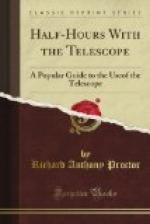Neptune also is easily found if his place be accurately noted on a map, and a good finder used. We have only to turn the telescope to a few stars seen in the finder nearly in the place marked in our map, and presently we shall recognise the one we want by the peculiarity of its light. What is the lowest power which will exhibit Neptune as a disc I do not know, but I am certain no observer can mistake him for a fixed star with a 2-inch aperture and a few minutes’ patient scrutiny in favourable weather.
[Illustration: PLATE VII.]
CHAPTER VII.
HALF-HOURS WITH THE SUN AND MOON.
The moon perhaps is the easiest of all objects of telescopic observation. A very moderate telescope will show her most striking features, while each increase of power is repaid by a view of new details. Yet in one sense the moon is a disappointing object even to the possessor of a first-class instrument. For the most careful and persistent scrutiny, carried on for a long series of years, too often fails to reward the observer by any new discoveries of interest. Our observer must therefore rather be prepared to enjoy the observation of recognised features than expect to add by his labours to our knowledge of the earth’s nearest neighbour.
Although the moon is a pleasing and surprising telescopic object when full, the most interesting views of her features are obtained at other seasons. If we follow the moon as she waxes or wanes, we see the true nature of that rough and bleak mountain scenery, which when the moon is full is partially softened through the want of sharp contrasts of light and shadow. If we watch, even for half an hour only, the changing form of the ragged line separating light from darkness on the moon’s disc, we cannot fail to be interested. “The outlying and isolated peak of some great mountain-chain becomes gradually larger, and is finally merged in the general luminous surface; great circular spaces, enclosed with rough and rocky walls many miles in diameter, become apparent; some with flat and perfectly smooth floors, variegated with streaks; others in which the flat floor is dotted with numerous pits or covered with broken fragments of rock. Occasionally a regularly-formed and unusually symmetrical circular formation makes its appearance; the exterior surface of the wall bristling with terraces rising gradually from the plain, the interior one much more steep, and instead of a flat floor, the inner space is concave or cup-shaped, with a solitary peak rising in the centre. Solitary peaks rise from the level plains and cast their long narrow shadows athwart the smooth surface. Vast plains of a dusky tint become visible, not perfectly level, but covered with ripples, pits, and projections. Circular wells, which have no surrounding wall dip below the plain, and are met with even in the interior of the circular mountains and on the tops of their walls. From some of the mountains great streams of a brilliant white radiate in all directions and can be traced for hundreds of miles. We see, again, great fissures, almost perfectly straight and of great length, although very narrow, which appear like the cracks in moist clayey soil when dried by the sun."[14]




